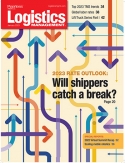Advances in Last-mile Delivery Take Shape
Last-mile delivery is expensive and complicated. Solutions range from smart lockers to GPS sensors and advanced data analytics look to change that equation.

Logistics in the News
Intermodal volumes finish 2022 with declines, reports IANA U.S. rail carload and intermodal volumes are mixed, for week ending January 14, reports AAR Single-Carrier vs. Multi-Carrier Shipping Stategies 论坛流动性heralds $400M joint venture with CBRE IM and Series A funding round Catching up with MHI’s Daniel McKinnon More Logistics NewsLogistics Resource
Single-Carrier vs. Multi-Carrier Shipping Stategies Download the white paper to learn about the benefits of multi-carrier shipping with EasyPost.
Download the white paper to learn about the benefits of multi-carrier shipping with EasyPost.All Resources
If there ever was a scrum in the supply chain, it’s last-mile delivery. And it’s a worldwide scrum, no less.
From China to Europe to the U.S., companies as divergent as Amazon,SF Express, Shipt, Instacart and XPO Logistics are pushing and shoving their way through the last-mile delivery maze.
Dr. Benoit Montreuilof Georgia Tech puts it much more elegantly. “We are working very hard right now to define the next generation of city logistics service solutions.” Montreuil is theCoca-Cola Material Handling & DistributionChair at Georgia Tech’s Stewart School of Industrial & Systems Engineering as well as director of the Physical Internet Center.
Looking around the world, Montreuil sees a vast difference in last-mile capabilities by continent. He says Europe has been the leader until recently. Now, Asia, especially China, is in the lead due to fast growth, less legacy and brutal competition. The U.S. is in third place. Nevertheless, last-mile is catching on here.
On the surface,last-miledoesn’t look all that tough. Just deliver goods from a regional distribution center or retail store to the consumer. But looks can be deceiving. And expensive, too. Some say nearly 30% of the total cost of all goods delivery is in last-mile.
Last-mile delivery is much more than navigating city streets, avoiding traffic congestion and finding the right address. Last-mile is also a matter of actually being able to deliver the goods, especially when no one is home but needs to be. And that doesn’t even include the challenges of building security, the scale of high-rises and parking availability. Oh, don’t forget the weather.
There are also many different schemes. Montreuil says there are seven different scenarios for last-mile delivery. They range from pickup at the store to ship directly to home and pickup at a nearby locker. His moniker of hyperconnected transportation rings true when you factor in all the transportation scenarios from messengers on bikes, Uber and similar ground-delivery services to the range of pick-up points such as Amazon lockers at Whole Foods grocery stores.
Earlier this month, Montreuil made yet another trip to China where he is working with several logistics service providers, including SF Express, on last-mile delivery.
He says that UPS and Amazon are the leaders in the U.S. with a total of a few hundred last-mile lockers. In China, Montreuil says there are 60,000 lockers. But just as Amazon has its lockers and UPS its, locker banks in China are shared by competitors, says Montreuil. That’s a completely different approach.
But it’s also an approach that is getting a look in the U.S., says Barbara Ivanov, director of the Urban Freight Lab at the University of Washington. This month and next, she is focused on a test of smart lockers in a 62-story building in downtown Seattle.
Ivanov:
“We’re trying to determine if smart lockers can reduce the time trucks spend at the building as well as total truck dwell time and undeliverable patterns.”
Collaboration is of major importance to solving the last-mile challenge, say both Ivanov and Montreuil. Key players are not just the shippers (retailers, distributors, manufacturers) and logistics service providers, (UPS, Shipt, XPO Logistics, Instacart). City and related government groups are essential too. See this issue’s NextGen Interview with Ivanov for more details on how her Urban Freight Lab is partnering with the City of Seattle.
Dr. Matthias Winkenbachof MIT echoes the others on the importance of cities in last-mile delivery. “No city is the same and within a city we don’t see two areas that are the same – you have to learn from previous delivery processes to become more efficient,” he says. He made the comment at the U.S. Department of Transportation’s Volpe Center late last year. Winkenbach is the director of MIT’s Megacity Logistics Lab and a research associate at the MIT Center for Transportation & Logistics.
That complexity is also where NextGen technologies enter the picture. They include sensors, big data, data analytics and the Internet of Things, just to start the list.
Wikenbach’s Lab makes strong use of data analytics to process delivery route data collected by GPS sensors and other telemetry devices. That is then connected to real-time traffic data and even weather conditions to optimize future last-mile deliveries.
Winkenbach, Ivanov and Montreuil are only at the front end of this process. But down the road, they will guide important efforts to use NextGen technologies to provide data that can translate into more efficient and timely last-mile deliveries in even the most densely populated cities.
Gary Forger is the special projects editor for Supply Chain Management Review. He can be reached at[email protected]


Subscribe to Logistics Management Magazine!
Subscribe today. It's FREE!Get timely insider information that you can use to better manage your entire logistics operation.
Start your FREE subscription today!
 Single-Carrier vs. Multi-Carrier Shipping Stategies
Download the white paper to learn about the benefits of multi-carrier shipping with EasyPost.
Download Today!
Single-Carrier vs. Multi-Carrier Shipping Stategies
Download the white paper to learn about the benefits of multi-carrier shipping with EasyPost.
Download Today!
 Our annual gathering of freight transportation industry analysts reveals some common themes, largely around the notion that rates are not likely to increase much—if at all—in some modes and will continue declining in others. Does this mean things are stabilizing?
Our annual gathering of freight transportation industry analysts reveals some common themes, largely around the notion that rates are not likely to increase much—if at all—in some modes and will continue declining in others. Does this mean things are stabilizing?LM Viewpoint on the 2023 Rate Outlook: Will shippers catch a break? Global Labor Rates: China is no longer a low-cost country View More From this Issue
 2023 Rate Outlook Webcast: Will shippers catch a break?
In this annual webcast, group editorial director Michael Levans hosts our panel of logistics and freight transportation analysts who share their insights on rate patterns in all the major transport modes in an effort to help shippers prepare their freight transportation budget for the coming year.
Register Today!
2023 Rate Outlook Webcast: Will shippers catch a break?
In this annual webcast, group editorial director Michael Levans hosts our panel of logistics and freight transportation analysts who share their insights on rate patterns in all the major transport modes in an effort to help shippers prepare their freight transportation budget for the coming year.
Register Today!








